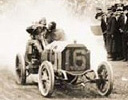Denver Diary:
Day Two
We’re Not Running on Empty Anymore
Denver, CO, August 13 — While there were two races run on the track, today’s major exhibition of speed was not immediately obvious. Saturday’s announcement of the 2006 Champ Car schedule actually carries that distinction. In many series, the announcement of next year’s schedule is not such a big deal. But for the Champ Car World Series, which announced its 2005 schedule in October 2004 and its 2004 schedule in March 2004, the timing of the schedule announcement represents a tremendous feat of speed. It also demonstrates the viability of the CCWS business plan as executed by series co-owner Kevin Kalkhoven and his business team. After buying the series out of bankruptcy in 2004, the series has steadily and dramatically improved with each event. Passed over as out of gas and out of potential, Champ Car is not running on empty any more.
Anyone attending the press conference today would also have a clear idea of who and what is driving the decisions in today’s Champ Car. Back in the day, it was the team owners who made the important decisions. The team owners were eventually neutralized by a variety of factors, but mostly by their own greed, satiated by the monies earned when CART went public. Eventually, this model gave way to a perpetual tug of war between promoters, as exemplified by IMS’ Tony George, and engine manufacturers, such as Honda and Toyota.
George wanted himself and other promoters to have a greater say in how CART was run. Engine manufacturers wanted to have as many competitive advantages as they could get, and had, as it turned out, no real commitment to the series. George took himself out of the equation by forming the Indy Racing League in 1995, and no other promoters stepped up to take true control of the series. The manufacturers simply left the series after correctly identifying the lack of viability in the public company known as CART. But, their defections were largely attributable to efforts made by George and much of the racing establishment to kill CART. And in an amazing display of karma, Tony George got exactly what he wanted, the manufacturers, away from CART, thus ensuring the eventual demise, at least in its current form, of the IRL.
Champ Car inherited the racing events as part of the bankrupt company’s assets, and it turned out to be the better part of the bargain. But, no longer burdened by self seeking team owners, as typified by Bobby Rahal, the company that is now CCWS is no longer mired in struggles between various factions. Instead, decisions are being made according to what makes business sense, according to what fits with the business plan, and by owners who seek to build the series into a viable, self-sustaining entity. This process, while appearing simple on the surface, is nonetheless enormously complex.
When it comes to venues for the series, there are few sacred cows, and because of this, the process is also painful. We have lost, perhaps forever, beloved road races at Road America, Mid-Ohio, and Laguna Seca. I will always miss these races being on the Champ Car schedule, but the fact remains that the public no longer turns out in large numbers for road racing events located far outside major metropolitan areas. Thus, these races no longer make business sense—they do not fit in a business sense. The remaining road courses, at Montreal and Portland, are located in large cities with high attendance and are thus secure.
Also in jeopardy, for differing reasons, are the two remaining oval events. In Las Vegas, the series is waiting to see how the doubleheader with NASCAR Craftsman Trucks will work in its second year. In our opinion, it did not work last year. What worked better when combining with Trucks is how the Fontana weekends were scheduled. The Trucks came in and did their one day deal on Saturdays and Champ Car raced on Sundays. While the attendance wasn’t as high as desired, Champ Car was not treated by the track as Chump Car, which was the case last year at LVMS.
I have both a theory and a prediction about Las Vegas. Since Kevin “Mr. Champ Car” Kalkhoven says that this city is a definite, I think the only reason why LVMS is still in play at all is because CCWS has not been able to put together a street race yet. As soon as they do, I predict that LVMS will go bye-bye.
As to Milwaukee, it’s still on the schedule because it’s an oval and in the Midwestern U.S. But, the problem with the mile is with the promoter, or rather the lack of an effective, stand-alone promoter. I also predict if the attendance is not there in 2006, it’s going to be absent from the 2007 schedule, no matter how rich the history of Champ Car and the Mile has been and is.
Oh, and one final prediction about schedules. The death knell of the IRL will be when you again hear the Indianapolis 500 announced as part of the Champ Car schedule. With the mass defection of manufacturers from the IRL, it’s only a matter of time before IMS will require Champ Car drivers to fill its field for the 500 like a vampire needs blood.
The racing was not too spectacular on Saturday. Klaus Graf won the Trans Am race. The qualifying for Champ Car and Atlantics pretty much mirrored what happened on Friday. Which is to say, nothing much changed. We hope the racing tomorrow is exciting—although as exciting as last year would be perhaps hoping for too much.
Copyright © 2005 by Lisa Davidson and Deep Throttle. All Rights Reserved.
|




